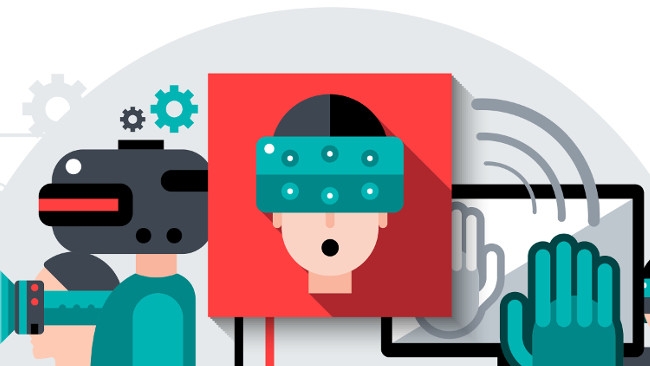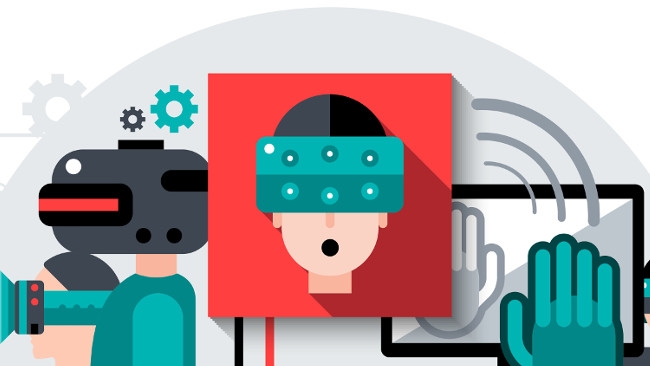
 VR graphic by shutterstock.com
VR graphic by shutterstock.com
VR cinema presents a host of creative issues, but the solutions may give birth to films that bear an increasing resemblance to games.
Recently, we published an article that gave voice to some of my concerns pertaining to VR cinema. Simon Wyndham went a little further in his criticisms than perhaps I would have, drawing parallels between VR and failed 3DTV offerings. But, at its heart, Simon's post is really a examination of the inadequacies of 360 video, VR 'live action' video and 'films' that adopt this approach.
I'm a big proponent of virtual reality, augmented reality and whatever 'mixed' realities that will inevitably arise when VR and AR technologies are blended. But, to be honest, 360 video experienced through a VR headset, whether it's an Oculus Rift DK2, a Samsung Gear VR or a low-end Google Cardboard, leaves me a bit cold. Maybe I'm jaded, as much of the newness for VR has worn off for me, but whether I'm following a group of mountain climbers, snowboarders or astronauts, the feeling of immersion quickly wears off.
Sketches vs. paintings
In all fairness, these early examples of VR video don't rise to the level of 'cinema', but that apparently was not the intention of their makers. These experiences are more like quick takes, or rather teasers, which provide a glimpse into what's possible with the platforms. That said, the greatest competing factor for VR cinema is the wealth of traditional, 2-D cinematic content and our own standards of production and story quality, developed over lifetimes of viewing experience.
There may still be hope for 'live action' VR cinema, as there is an abundance of new startups and production companies trying to gain a foothold in that burgeoning industry. And every month brings news of another VR camera in development, with the likes of Jaunt, GoPro, Nokia, Sphericam, Panasonic and others with cameras available or in preparation for impending release. With this high level activity around VR cinema and increased availability of tools, if it's possible to solve the problems of constructing and delivering compelling narratives for VR, then these early pioneers of the platform will do just that.
Repeatability
I'm sure that, as we're in the early stages of a VR video content explosion, the questions surrounding VR storytelling will be answered in a variety of ways. Over time, standards will coalesce around the most popular of these answers. I'm not going to get into the minutiae of these quandaries, but suffice to say that dilemmas like 'how to cut from scene to scene' will be solved.
However, when I think of VR storytelling, I can't help but think of one enormous advantage of the platform, namely repeatability. Traditional cinema content may yield repeat viewings, but VR cinema is a tailor-made for multiple viewings (if a given project is conceived as such).
Imagine a film like Robert Altman's Shortcuts. Now, imagine the ability to watch the same film five times, each time following a different character or jumping around to the plots and subplots of your choosing.
If we're adopting this model, a work of VR cinema wouldn't be a 'film' in the classic sense of the word. Instead, a work of VR cinema may contain a television series season's worth of content occurring concurrently, with the viewer given the power to pick and choose the experience, moment-by-moment.
When Games met Films
Of course, this all begs the question, "how do present VR live action video that provides greater user interaction?"
The answer will likely be found in the marriage of cinema and games.
Imagine a piece of VR cinema whereby traversing the space, say that of a mansion, occurs in a game environment, with each room and area a portal for live action 360 video. Everything happens in 'real-time'; the viewers (or would it be 'players'?) can join and leave scenes as they deem fit.
Or VR cinema could ape the classic 'Choose your own adventure' model. Or VR cinema could go even farther into game territory, with a greater level of decision-making that could impact the developing narrative, such as being in a particular room at a particular time determining which version of Act Three you experience. Or VR cinema could call for the manipulation of virtual objects within the game environment that, again, impact narrative.
There's a deep well of possibilities for VR cinema. But, in order to realize the most compelling of these possibilities, we may have to expand what it is we mean when we say "cinema."
Graphic by Shutterstock
Tags: VR & AR


Comments